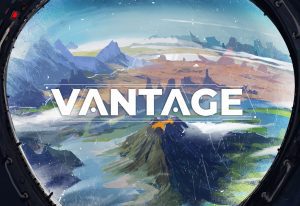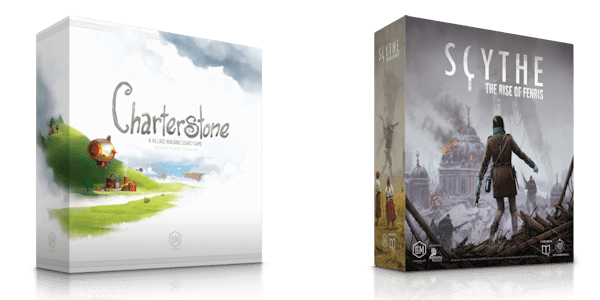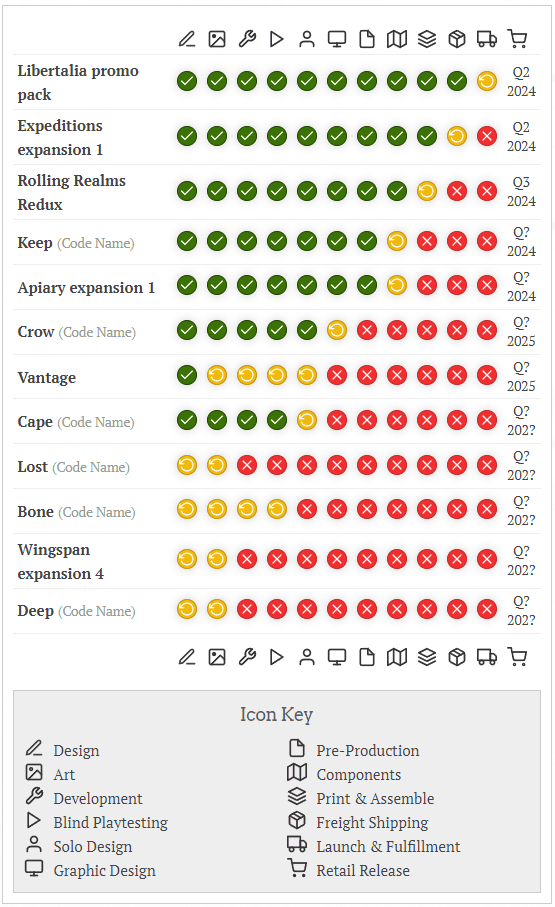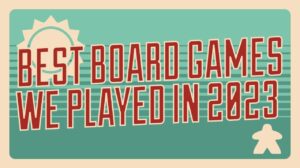
Stonemaier Games started with the game Viticulture as a crowdfunding campaign on Kickstarter. Since then, Jamey Stegmaier and his crew have released a total of 17 games, and have just recently announced their latest game, Vantage, to be released in 2025. Of their 17 released games, three rank high enough to be in the top 50 games over on BoardGameGeek (Scythe, Wingspan, and Viticulture).
I am a fan of the company, their games, and their founder. I am a Stonemaier Champion; the first review I did for Meeple Mountain was for Between Two Cities. (I soon followed up with a review of its expansion.)
So, without further ado, I am honored to present to you six questions with Jamey Stegmaier.
Six Questions
Q1: Stonemaier Games has a reputation for doing all that it can to be a good corporate citizen of the world. This comes in many forms, from how you look at packaging in order to be kinder to the environment, to how you seek out people to work with in order to be more diverse. Can you describe the process you use to determine where you need to improve? What initiatives have been the most successful? Have any fallen through?
Thank you! We’re trying to spread joy to tabletops worldwide, and that includes inclusion, accessibility, eco-friendliness, and adding value to others through the content we create. It’s all a work in progress—there’s plenty of room for improvement, from eliminating plastic shrinkwrap from the exterior and interior of our games to increasing the text size and contrast so it’s as vision-friendly as possible. I’m always looking to improve our rulebooks and user interface to make our games as intuitive as possible.
I would actually say that one of our most successful initiatives is also the one that has “fallen through”, depending on who you ask: We replaced all plastic containers inside Wingspan with sugarcane pulp trays, a far more costly endeavor than plastic trays. Yet consumers repeatedly told us that they thought we were trying to cut costs by making the change and that they wanted the plastic trays back. We heard this feedback enough that we’ve decided to go back to the old trays. The wooden eggs are here to stay, though.
Quick follow-up: Being a good corporate citizen is a difficult line to walk. Even when you do the right thing, there are those that will not see it that way (for example, your experience with the trays). What steps do you take to ensure that customers understand that Stonemaier Games’ dedication to such measures is genuine?
I really like this question on multiple levels. Overall, I believe that trust is earned through sustainable action. If we say we care about the environment but we don’t actually act on our words (or the way we act is just a short-term patch instead of a long-term effort), no matter how genuine our intentions are, they aren’t having the intended impact. Yet I would also say that saying the words actually matters: Talking transparently and publicly about what we believe in (as I do every day) has power. I cringe whenever I see someone dismiss something that anyone says as “virtue signaling”—at least they have the courage to speak up, even if there’s a long journey ahead regarding how they put those words into action.

Q2: You have produced two games that touch on the Legacy Game design space (Charterstone and The Rise of Fenris for Scythe). Has this scratched the Legacy-itch for you, or do you see Stonemaier Games producing any more? Was this foray into Legacy games something you consider a success? Is there another class of game that Stonemaier has not yet explored that you would like to delve into? Is there a class of game that nobody has done that Stonemaier is currently exploring?
Charterstone is the only legacy product (one that features permanent changes that cannot be undone) that we’ve published, but there are surprises, unlocks, and branching paths in The Rise of Fenris that have overlap with most legacy games. To date, we’ve sold just under 100,000 units of Charterstone (plus the digital version) and it’s rated 7.2 on BoardGameGeek. We’ve sold 134,000 units of The Rise of Fenris expansion, and it’s rated 8.7 on BoardGameGeek. By the numbers, I would say that we achieve the goal of these products bringing joy to people.
I recently announced Vantage, a cooperative open-world game with a level of freedom and scope I don’t think I’ve seen in any tabletop game. As for a new-to-us class of game I’d like to delve into someday, I would like us to have a clever deckbuilding game at some point.
Q3: Games from Stonemaier have included many mechanisms (e.g., worker placement, hand and resource management, tile laying). Some of those mechanisms have been used multiple times (worker placement seems to be a favorite). What mechanisms would you like to explore in future games? Are there mechanisms you have used that, in retrospect, should have been some other mechanism instead? Do you feel that there are mechanisms that you have used that have more design space to be explored? If so, what would those be?
Beyond the aforementioned deckbuilding, the other mechanism I love and would like to explore is tug-of-war. That’s an interesting question about mechanisms that should have been other mechanisms—there are tiny tweaks I sometimes think of in regards to our games, but not entire mechanical changes. Someday I’d like to return to worker placement to see what I can add to the genre (if anything).
Quick follow-up: Deck building and worker placement are interesting mechanics. What sort of innovation with deck building (in other games) has caught our eye? What about worker placement? As a company that has explored worker placement several times, what sort of innovation with worker placement do you feel has yet to be explored?
I really love what Dune Imperium did to combine worker placement with deckbuilding. I also think Abandon All Artichokes is really clever (try to fill your hand with a single type of card). And Quacks of Quedlinburg is peak bagbuilding design to me. For worker placement, Shem Phillips at Garphill Games is endlessly innovative with the genre—he’s always several steps ahead of everyone else there, in my opinion.

Q4: You have an amazingly large online presence! From Facebook to YouTube, between making content and answering questions/comments, one can imagine that you have very few hours in a given week where you can spend time with non-Stonemaier Games pursuits. Your love of disc golf is well known, you talk about the games you play in many of your videos, and it would appear that you are able to maintain a healthy social life. Bravo! How do you manage your time in such a way as to ensure that you have time to decompress? Aside from disc golf and board games, what are the things that help you to recharge the most? What are the biggest challenges when it comes to carving out time?
While I typically work around 70 hours a week, that still leaves 42 waking hours for other activities. My time management largely revolves around habits and patterns: I typically work from 7:00-11:00 in the morning, then 11:45-6:00 in the evening, then a few hours after dinner. That’s the right amount of time for me. Weekends are a bit more flexible, as that’s when my friends are the most flexible. I love strolling through the local farmer’s market to buy fresh produce and treats, and I often decompress during dinner in the evenings with a few shows or movies—there’s so much quality content out there! My daily workout in the morning is also a great way to recharge (or charge, really), especially while listening to an engaging podcast. The biggest challenge is the unexpected: I never know when a day will throw a huge curveball at me. Fortunately, Stonemaier now has an amazing staff who are capable of handling and supporting when the unexpected happens.

Q5: I am tempted to ask you about the code names for upcoming products, but I suspect that would be a non-starter. 🙂 So I will instead ask you about the process for getting games from concept to the customer’s table. On your website and in your newsletters you include a chart that shows the process starting with design and ending with retail release. Which of these steps is the most challenging? The most time-consuming? The most rewarding? The most frustrating? Have you, to date, had a game reach code-name status and not make it through the whole process? If so, what caused that one to fall through?
It depends on the game. Expeditions, for example, was the most challenging during the core design process, as it proved incredibly difficult to design a game that felt like Scythe but wasn’t Scythe. For other games, it’s playtesting and development that can take a long time. Proofreading and oversight is also a big challenge, as we want everything to be as perfect as possible. The most fun stages for most games are the early brainstorming stages and the late design stages when the game is really singing. We have indeed had a game reach codename status and then fall off the list when playtesters never rated it highly enough for us to move forward with it—we take their ratings quite seriously, and we won’t publish something we don’t think people will love.
Q6: You have in your catalog games that describe worlds that are not only beautiful, but which have an amazing background rife with history and possibility. This suggests —to someone like me—a world that could be explored well beyond the confines of the board game. Examples include the worlds of Scythe, Libertalia, and Apiary (and in odd ways: Charterstone, Euphoria, and Wyrmspan). Would you ever consider producing a role playing game, or perhaps licensing one of your game worlds for someone else to do so? How about licensing one of those worlds for a novelization or a comic? Why or why not?
RPGs are a type of gaming that I know very little about, and I think it’s unlikely that we or someone else could publish an RPG for one of our worlds. It’s a different distribution and retail system than tabletop games, and while we could just license to another publisher, it would involve a huge level of trust for them to accurately portray the world (at least, without requiring a significant amount of our time to confirm their decisions).
The same probably goes for a novel, but I’m an avid reader and writer, so I feel more equipped to judge the quality of a novelization. I would love for one of our worlds to come to life on the little or big screen—again, it would require a lot of trust, and none of us have time to spend in a studio, but I can read a script and storyboards to offer input and approval. Honestly, I think the most likely games of ours for people to see on film are IPs for which we only have the tabletop rights and don’t have any other insider information: Scythe (Jakub Rozalskis’ 1920+ world) and Red Rising (Pierce Brown’s series of novels). I’d love to see both happen!
Afterwards
As I indicated in the intro to this interview, I am a fan. I have all of the games that Stonemaier has released with the exception of My Little Scythe. Of those games, the only one that has truly fallen flat with me was Pendulum. (I have some issues with Wyrmspan, but those are correctable.) Overall, I think Stonemaier Games is an excellent company that produces excellent games.
The last thing I want to say is that I believe that Jamey Stegmaier and his company follow up their lofty aspirations with actions.
- I have had to request a replacement part from them twice, and neither time did it cost me anything to get the part I needed.
- I have been playing a game late in the evening and had a rules question. I posted my question on BoardGameGeek figuring we could continue and check the site in the morning. Joe, one of the dedicated employees of Stonemaier, posted an answer within a few minutes.
- When he said, above, that they spend a lot of time on the manuals trying to make them right, there is proof of this dedication: when the combined Scythe rulebook had issues, they reprinted them and sent the people who ordered and received the originals new copies.
This company has no problem going above and beyond.











Add Comment